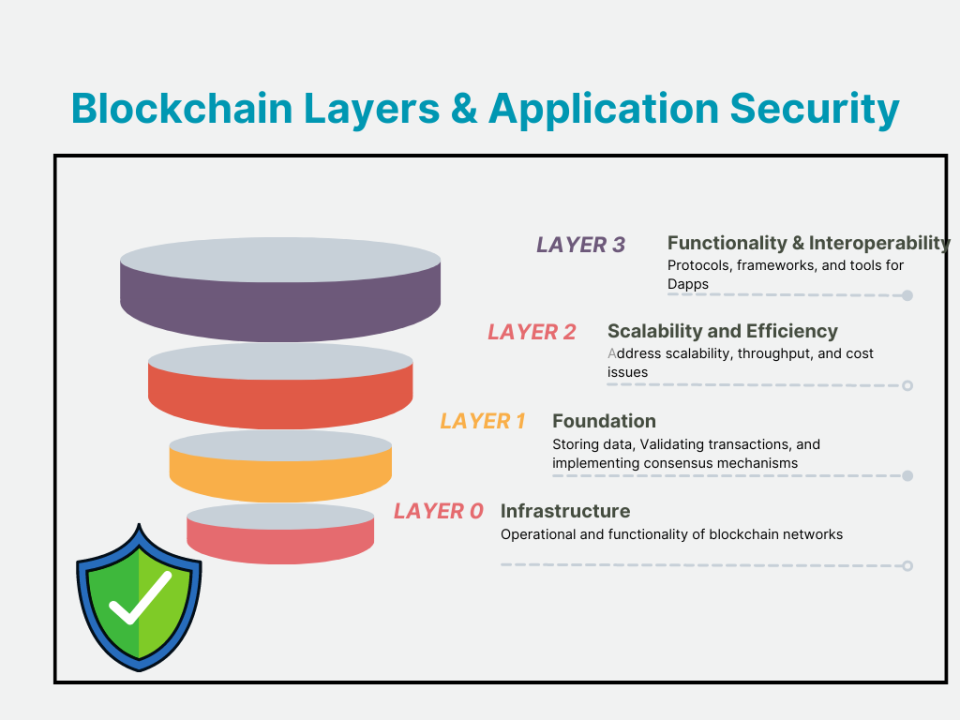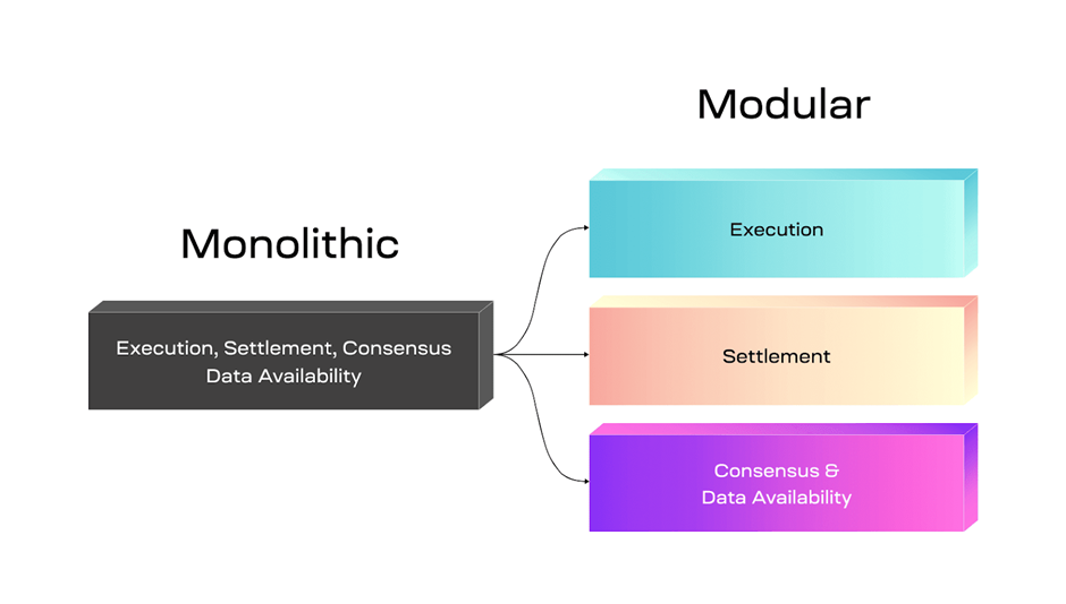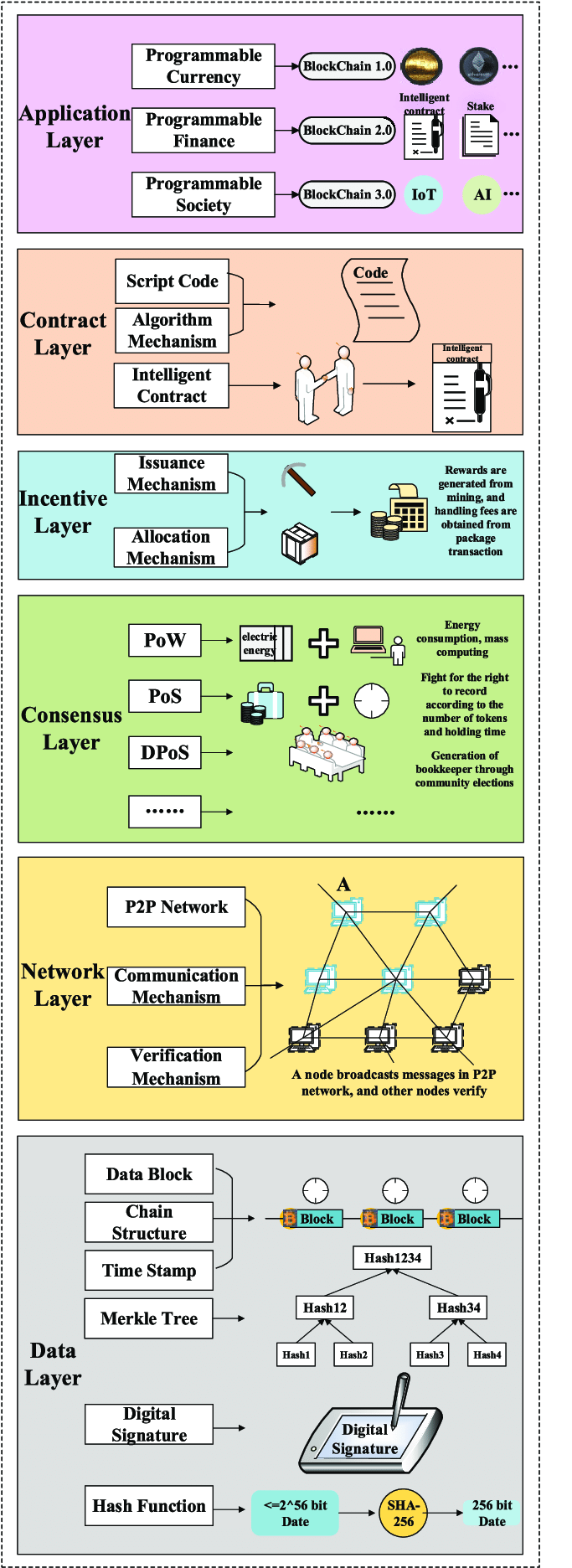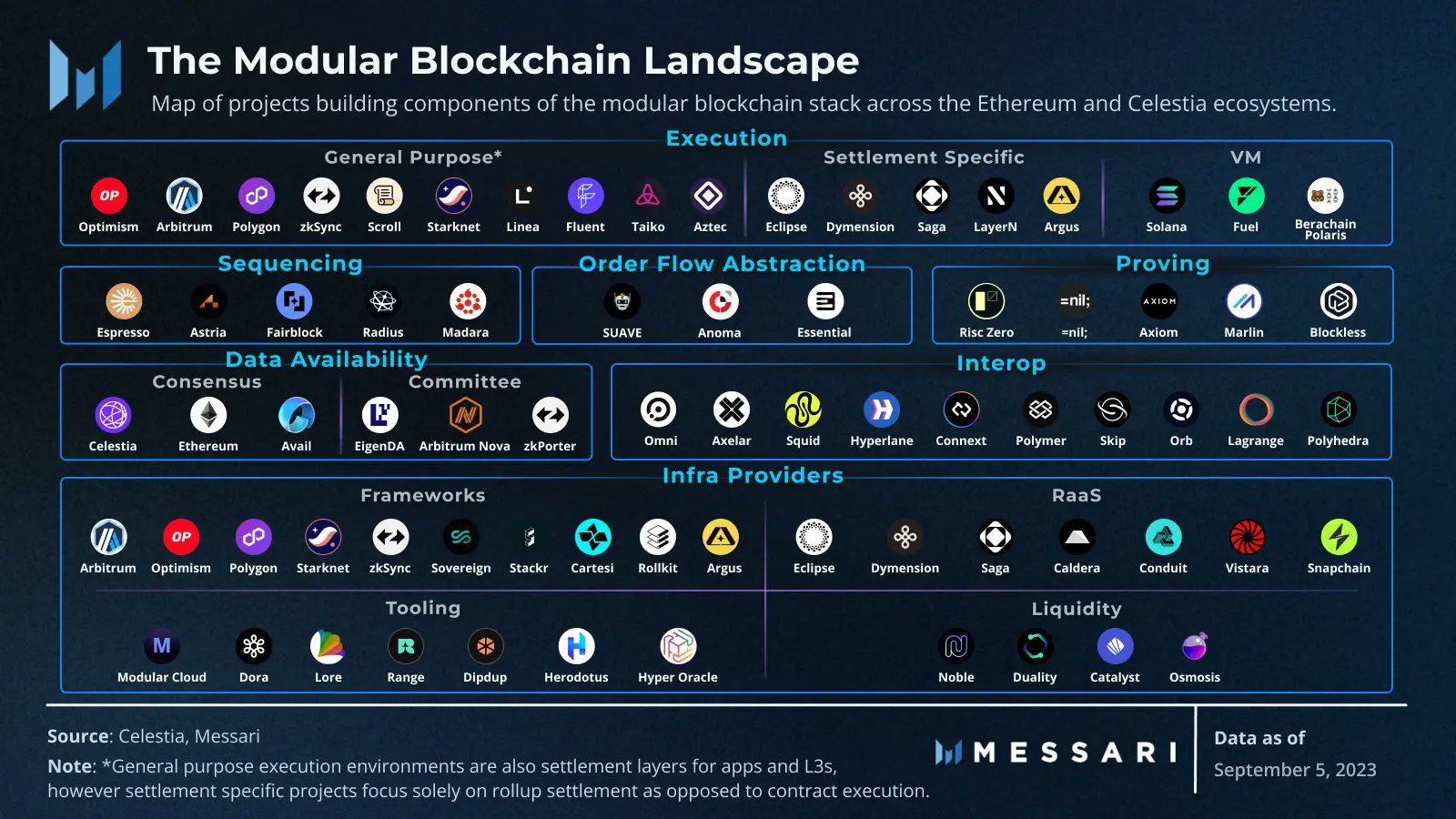
Key Takeaways
- Blockchain infrastructure forms the foundational layer of decentralized networks, encompassing consensus, execution, data availability, storage, messaging, and developer tooling.
- The industry is shifting from monolithic to modular blockchain architecture, where specialized layers, like Celestia for data availability or EigenLayer for restaking, optimize performance, flexibility, and scalability.
- Sectors like DeFi, gaming, AI, NFTs, identity, and DePIN rely on robust infrastructure to support use cases that demand real-time data access, composability, and decentralized coordination.
- A growing ecosystem of infrastructure providers, including Lava, Avail, Hyperlane, Dymension, and Rollkit, offers customizable, scalable services for dApp developers, DAOs, and enterprises.
- Adequate blockchain infrastructure enhances decentralization, reduces costs, improves security, and supports cross-chain innovation, making it essential for the next generation of Web3 applications.
Blockchain infrastructure forms the technical backbone of the decentralized internet. Just as traditional internet services rely on centralized providers like Amazon Web Services (AWS) and Google Cloud, blockchain-based applications require a completely different stack: decentralized, verifiable, and censorship-resistant. This infrastructure layer supports everything from basic transaction validation to complex application-specific rollups, ensuring Web3 protocols can operate at scale with security, reliability, and modular flexibility.
This Innovation and Tech article explores the concept of blockchain infrastructure, from its fundamental components and modular architecture to the sectors it supports and the emerging ecosystem of protocols driving innovation.
Defining Blockchain Infrastructure
Blockchain infrastructure encompasses the underlying components that enable decentralized networks to function. This includes systems responsible for consensus, computation, data availability, storage, messaging, interoperability, and developer tooling. Unlike Web2 architecture, which relies on centralized cloud providers, blockchain infrastructure is designed to operate across distributed nodes without single points of failure.
At the core of this infrastructure are Layer-1 blockchains like Ethereum, Solana, and Cosmos, which provide the base execution environment for smart contracts. These are increasingly complemented by Layer-2 solutions, such as Arbitrum, Optimism, and ZKsync, which enhance scalability through rollups or zero-knowledge proofs.

New paradigms like modular blockchains introduce infrastructure components like Celestia, which provides decentralized data availability, and EigenLayer, which enables restaking to secure new services using existing trust assumptions. RPC relayers, bridges, and indexers are also key parts of this infrastructure, supporting transaction relay, cross-chain asset movement, and data querying, respectively.
Together, these tools form a decentralized backend that allows applications to remain performant, composable, and transparent, making blockchain infrastructure the invisible yet essential scaffolding for the Web3 world.
The Modular Blockchain Stack
Historically, blockchains were monolithic, meaning all core functions, consensus, execution, and data availability, were handled within a single layer. While simple, this architecture limited scalability and flexibility. Today, the space has shifted toward modular architecture, which unbundles these responsibilities and delegates them to specialized layers.

Consensus Layer
The consensus layer secures the network and determines the ordering of transactions. It includes protocols like Ethereum’s Proof-of-Stake (PoS), Bitcoin’s Proof-of-Work (PoW), and emerging designs like EigenLayer’s restaking, which extends Ethereum’s security guarantees to new middleware services. Modular DA chains like Celestia and Avail are also experimenting with data availability sampling (DAS) to make consensus on data availability more scalable and lightweight.
Execution Layer
The execution layer is where smart contracts are run. The Ethereum Virtual Machine (EVM) remains the dominant standard, but newer execution environments like Move (used by Aptos and Sui) or Solana’s high-performance parallel runtime offer unique benefits in terms of throughput, latency, and programmability.
Data Availability Layer
Data availability ensures all published transaction data is accessible and verifiable by light clients and validators. Celestia, EigenDA, and Avail are purpose-built for this task, enabling rollups and modular blockchains to publish data off-chain without sacrificing transparency. These layers reduce congestion on Layer-1s while preserving auditability.
Settlement Layer
The settlement layer acts as the final source of truth. For example, Ethereum serves as the settlement layer for many rollups, validating state transitions and anchoring proofs from Layer-2s. Settlement layers are critical in maintaining composability and trust in modular ecosystems.
Messaging & Interoperability
Messaging protocols like IBC (Inter-Blockchain Communication), Wormhole, Axelar, and LayerZero enable communication and asset movement between independent chains. These interoperability layers are key to the rise of appchains and the broader interchain ecosystem, allowing protocols to share liquidity, state, and user bases.
Middleware Infrastructure
Supporting these layers are middleware services like Lava, Ankr, and QuickNode, which provide access to blockchain data through decentralized RPC endpoints. Indexing protocols like The Graph, SubQuery, and Subsquid enable developers to query structured on-chain data, enhancing frontend performance and UX. Observability tools like Tenderly and Blocknative offer developer-friendly environments for debugging, monitoring, and simulating transactions in real-time.

Blockchain Infrastructure Use Cases Across Sectors
Blockchain infrastructure is not an abstract technical concept; it underpins real-world use cases across major sectors of the decentralized economy.
In DeFi, infrastructure enables composability, scalability, and asset interoperability. Rollups and DA layers allow protocols to settle complex trades, execute liquidations, and optimize capital efficiency, all without congesting Layer-1 networks.
In blockchain gaming, high-throughput chains like Ronin, Immutable X, and Arbitrum Nova allow for micro-transactions, ownership of in-game assets, and on-chain economies that scale to millions of players.
AI and DePIN (Decentralized Physical Infrastructure Networks) rely on compute networks, decentralized storage, and modular coordination systems to serve data-hungry models and smart sensors. Protocols like Akash, 0G, and Gensyn are designed to support these workloads with cryptographic guarantees and marketplace incentives.
In the NFT and creative media sectors, infrastructure like Arweave, IPFS, and Livepeer provides long-term storage, content delivery, and decentralized rendering, all critical for ensuring the permanence and integrity of digital media.
For identity and social, protocols like Lens, CyberConnect, and Farcaster depend on decentralized infrastructure for verifiable credentials, social graphs, and zk-based identity proofs. This layer ensures that users can own and port their social identities across platforms while maintaining privacy.
Whether enabling real-time strategy execution in DAOs or supporting persistent digital identities, blockchain infrastructure is the substrate on which nearly every Web3 use case is built.
Leading Infrastructure Protocols and Builders
Several notable protocols and teams are building the infrastructure backbone of Web3:
- EigenLayer: Pioneers Ethereum restaking, allowing validators to secure additional networks and services while earning rewards.
- Celestia: Focused on data availability, enabling lightweight blockchains and rollups to publish and verify data efficiently.
- Avail: Spun out from Polygon, Avail offers general-purpose DA for rollups and appchains.
- Lava Protocol: A decentralized RPC and indexing layer that ensures reliable dApp connectivity.
- Rollkit: Enables developers to deploy sovereign rollups using modular components like Celestia for DA.
- Hyperlane: A permissionless messaging protocol supporting interchain applications across ecosystems.
- Dymension and AltLayer: Rollup-as-a-Service providers, simplifying appchain deployment with customizable execution and settlement layers.
- Anoma and Namada: Focused on privacy-preserving infrastructure, intent-based execution, and encrypted asset transfer.
- Caldera and Nolus: Infrastructure startups offering modular scaling, custom VMs, and appchain orchestration tools.
These infrastructure providers offer developers the modularity and scalability needed to build advanced, performant, and secure blockchain applications without reinventing the wheel.

Benefits of a Robust Blockchain Infrastructure
An effective infrastructure stack provides foundational advantages that define Web3’s unique capabilities.
Scalability: Modular chains allow horizontal scaling and enable ecosystems to grow without bottlenecks. Rollups and DA layers decouple computation and storage, improving efficiency.
Decentralization: Infrastructure built across globally distributed nodes ensures trust-minimized operations, censorship resistance, and fault tolerance, critical for mission-critical applications.
Developer Flexibility: Through SDKs, APIs, and middleware services, infrastructure tooling lowers the barrier for building dApps, rollups, and services. Customizable frameworks allow teams to focus on product logic rather than protocol engineering.
Security: Shared security models (like Ethereum’s restaking via EigenLayer) and cryptographic proofs (e.g., zero-knowledge and fraud proofs) help secure protocols even in adversarial environments.
Composability: Interoperability protocols and standardized interfaces enable applications to plug into each other seamlessly. Developers can build atop existing infrastructure and integrate services from different providers with minimal friction.
These benefits make blockchain infrastructure not only vital for protocol performance, but also central to Web3’s long-term sustainability.
Blockchain Infrastructure: Building The Next Internet
Blockchain infrastructure represents the core foundation on which the decentralized internet is being built. From consensus and execution to data availability and interoperability, these modular components ensure that crypto-native systems remain performant, reliable, and open.
As the industry continues to scale and evolve, infrastructure protocols will play a key role in unlocking new markets, from DeFi and gaming to AI and physical infrastructure. Developers, DAOs, and enterprises alike are increasingly relying on a growing toolkit of interoperable components to deliver scalable, secure, and user-centric blockchain experiences.
Ultimately, the success of Web3 depends on the strength, adaptability, and decentralization of its infrastructure layer. The more robust this foundation becomes, the more powerful and inclusive the applications built on top of it will be.





